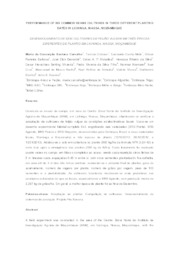Performance of six common beans cultivars in three different planting dates in Lichinga, Niassa, Mozambique.
Performance of six common beans cultivars in three different planting dates in Lichinga, Niassa, Mozambique.
Author(s): CARVALHO, M. da C. S.; COBUCCI, T.; MELO, L. C.; FERREIRA, G. B.; DENARDIN, J. E.; MUTADIUA, C. A. P.; SILVA, H. R. da; MIRANDA, C. H. B.; SILVA FILHO, P. M. da; NEUMAIER, N.; CRUZ, I.; ROCHA, M. de M.; ALMEIDA, R. P. de; MUSSA, V.; DAMBA, G.; KAUDA, J. B.
Summary: A field experiment was conducted in the area of the Centro Zonal Norte do Instituto de Investigação Agrária de Moçambique (IIAM), em Lichinga, Niassa, Moçambique, with the objective of checking out the performance of common beans cultivars in response to local environmental conditions. A complete 6x3 factorial experimental design was used, encompassing six cultivars of common beans (BRS Pontal, BRS Agreste, BRS Perola, and BRS Requinte, developed by Embrapa, Brazil; and two locals, Manteiga and Encarnada), and three planting dates (12/12/2012, 29/12/2012, e 13/01/2013). There was soil cover fertilization at planting (500 kg/ha of the mixed NPK 2-24-12) and after 20 days of plants emergency (130 kg de N/ha). Each treatment was replicated four times in the field, in randomized blocks (18 m2 each, with five liner of six lineal meters each, spaced 0,45 cm, with nine seeds seeded per meter). At harvest (area of 3 m within the central lines), it was evaluated the plant final stand, degree of lodging, number of pods per plant, number of grains per pod, weight of 100 grains, and productivity. The Brazilian cultivars showed higher productivity than the local ones within the studied conditions, especially BRS Agreste, with an average production of 2,387 kg of grains/ha. The best planting date was at the end of December.
Publication year: 2014
Types of publication: Paper in annals and proceedings
Unit: Embrapa Rice & Beans
Observation
Some of Embrapa's publications are published as ePub files. To read them, use or download one of the following free software options to your computer or mobile device. Android: Google Play Books; IOS: iBooks; Windows and Linux: Calibre.
Access other publications
Access the Agricultural Research Database (BDPA) to consult Embrapa's full library collection and records.
Visit Embrapa Bookstore to purchase books and other publications sold by Embrapa.

